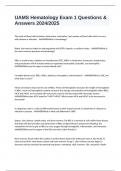UAMS Hematology Exam 1 Questions &
Answers 2024/2025
The study of blood cell formation, destruction, maturation, and number of blood cells which can vary
with disease or infection. - ANSWERSWhat is hematology?
Blood, that may be clotted or anticoagulated with EDTA, heparin, or sodium citrate. - ANSWERSWhat is
the most common specimen of hematology?
RBCs or erythrocytes, platelets or thrombocytes (PLT), WBCs or leukocytes, monocytes, lymphocytes,
and granulocytes which include banded or segmented neutrophils, basophils, and eosinophils. -
ANSWERSWhat are the types of normal blood cells?
Complete blood count. RBCs, WBCs, platelets, hemoglobin, and hematocrit. - ANSWERSWhat is CBC and
what does it count?
Mean cell volume measures the size of RBCs. Mean cell hemoglobin measures the weight of hemoglobin
in RBCs. Mean cell hemoglobin content measures the average concentration of hemoglobin within RBCs.
MCH and MCHC are increased with macrocytic anemia and decreased with microcytic anemia. -
ANSWERSWhat does MCV stand for? MCH? MCHC? What causes MCH and MCHC to be increased or
decreased?
It categorizes cells in a 100-cell differential based on their maturity levels, to determine if a disease or
infection is present. - ANSWERSWhat is white cell differential? (diff)
Spleen, liver, thymus, lymph nodes, and bone marrow. The RES is a network of cells within these tissues
that help with the formation and destruction of RBCs to fight infection and prevent bleeding, the
metabolism of iron to give to RBCs to carry oxygen through hemaglobin, inflammation, and immunity. -
ANSWERSWhat are the organs of the RES and what is their function?
Bone marrow, found within the cavities of cortical bones where the trabecular bone is also found. In
utero and at birth, most bones contain red bone marrow. At age 7, sites of bone marrow begin to
decrease and are restricted to proximal long bones, vertebrate, skull, sternum, ribs, and pelvis. Adults
, have 50:50 ratio of red to yellow bone marrow. - ANSWERSWhat is one of the largest organs in the body
and where is it found? Is the site of active bone marrow always the same?
There are two types of bone marrow. Red that is actively producing RBCs, and yellow that is inactive,
mainly composed of fat cells. Red bone marrow is composed of extravascular cords that contain all blood
cell lineages, stem cells, progenitor cells, adventitial cells, and macrophages. The cords are semi liquid
and wedged between sinuses, supported by trabeculae. - ANSWERSWhat are the types of bone marrow?
What is the composition of red bone marrow?
Periosteal arteries that wrap around the central vein supply blood. The periosteal arteries branch out to
form capillaries and sinuses which hook up to larger veins to return the blood to circulation. -
ANSWERSHow does red bone marrow receive blood supply?
The cells are released as the body needs them. RBCs are kept at a steady rate. Adventitial cells forming a
discontinous line along the sinus will retract allowing the RBCs to exit into circulation.
If needed, the yellow bone marrow can convert into red marrow to help make RBCs. - ANSWERSHow are
cells released from the bone marrow? What are measures the body can take if RBCs aren't able to be
supplied fast enough?
Lymphocytes, plasma cells, and macrophages. They play a role in producing new lymphocytes,
interacting with antigens and making antibodies, and ridding the blood of bacteria and debris. -
ANSWERSWhat do the lymph nodes encapsulate? What do these do?
Spleen, it functions to act as a filter for blood to remove old or deformed RBCs from circulation. These
RBCs will either be culled (destroyed entirely) or pitted (macrophages bite out damaged section). The
spleen can also become a site of RBC production if needed and is also a holding cell for platelets. -
ANSWERSWhat is the largest lymphoid organ? What does it do?
It has a red outer pulp and an inner white pulp. Blood passes through the red pulp first that has
macrophage lined cords that determine if RBCs need to be removed or not. The blood then enters the
inner white pulp where the sinuses are to re-enter circulation. - ANSWERSWhat is the composition of the
spleen?
A spleen might be removed to treat some cases of anemia. The blood would be seen to have a higher
RBC count, but some of them would be deformed or damaged. The blood would also be seen to have a




